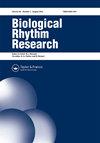慕尼黑时型问卷指数与最低核心温度时间的关系
IF 0.9
4区 生物学
Q3 BIOLOGY
引用次数: 0
摘要
摘要本研究的目的是检验慕尼黑时间型问卷(MCTQ)指数与最低核心温度下的时间之间的相关性。九名运动员被要求回答MCTQ问卷,并在夜间监测他们的核心体温。在MCTQ中,计算了空闲日的睡眠中点,该中点是根据工作周累积的睡眠债务(MSFsc)进行校正的。使用带有可摄入胶囊型传感器的遥测系统监测堆芯温度。研究了最低堆芯温度下的MSFsc与时间之间的相关性。最低堆芯温度下的MSFsc和时间范围分别为2.54–7.75(平均值±SE:4.54±0.52,95%CI:3.52–5.55)和3:43–7:41(平均值?SE:5:24±0:32,95%CI:4:21–6:27)。四名MSFsc晚于4.96的参与者在最低核心温度下的时间晚于6:00。在最低核心温度下,MSFsc与时间之间存在显著相关性,相关系数非常高(r=0.86,p<0.01)。这些结果表明,MSFsc可能有助于找到在上午比赛中更有机会提高昼夜节律的运动员。本文章由计算机程序翻译,如有差异,请以英文原文为准。
Relationships between the Munich Chronotype questionnaire index and time at minimum core temperature
ABSTRACT The purpose of this study was to examine the correlation between the Munich ChronoType Questionnaire (MCTQ) index and time at minimum core temperature. Nine athletes were requested to answer the MCTQ questionnaire and monitor their core temperature during night. In the MCTQ, the midpoint of sleep on free day, which is corrected for sleep debt accumulated during the workweek (MSFsc), was calculated. The core temperature was monitored using a telemetric system with an ingestible capsule-type sensor. The correlation between the MSFsc and the time at the lowest core temperature was examined. The range of MSFsc and time at minimum core temperature were 2.54–7.75 (mean ±SE: 4.54 ± 0.52, 95%CI: 3.52–5.55) and 3:43–7:41 (mean ±SE: 5:24 ± 0:32, 95%CI: 4:21–6:27), respectively. Four participants with their MSFsc later than 4.96 showed times at minimum core temperature later than 6:00. A significant correlation between the MSFsc and time at minimum core temperature was observed, with a very high correlation coefficient (r = 0.86, p < 0.01). These results suggest that the MSFsc may be useful to find athletes who have a better chance to advance their circadian rhythmicity for morning competitions.
求助全文
通过发布文献求助,成功后即可免费获取论文全文。
去求助
来源期刊

Biological Rhythm Research
生物-生理学
CiteScore
3.00
自引率
9.10%
发文量
34
审稿时长
6-12 weeks
期刊介绍:
The principal aim of Biological Rhythm Research is to cover any aspect of research into the broad topic of biological rhythms. The area covered can range from studies at the genetic or molecular level to those of behavioural or clinical topics. It can also include ultradian, circadian, infradian or annual rhythms. In this way, the Editorial Board tries to stimulate interdisciplinary rhythm research. Such an aim reflects not only the similarity of the methods used in different fields of chronobiology, but also the fact that many influences that exert controlling or masking effects are common. Amongst the controlling factors, attention is paid to the effects of climate change on living organisms. So, papers dealing with biometeorological aspects can also be submitted.
The Journal publishes original scientific research papers, review papers, short notes on research in progress, book reviews and summaries of activities, symposia and congresses of national and international organizations dealing with rhythmic phenomena.
 求助内容:
求助内容: 应助结果提醒方式:
应助结果提醒方式:


